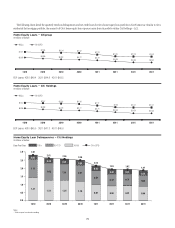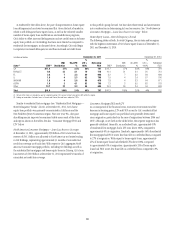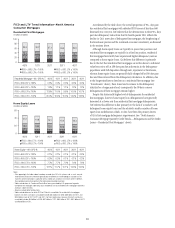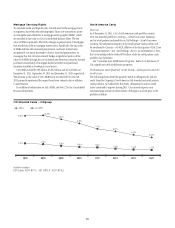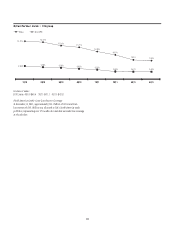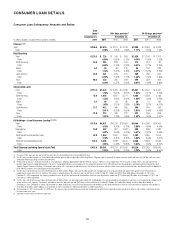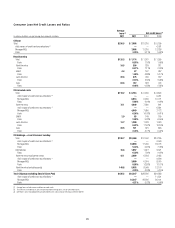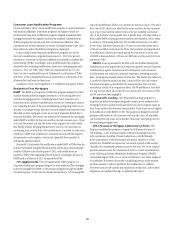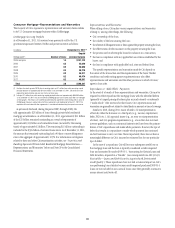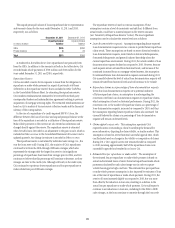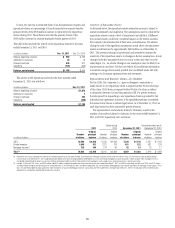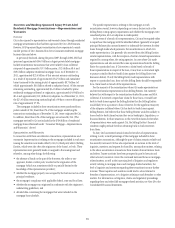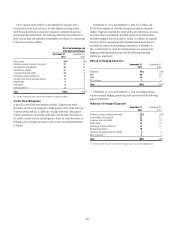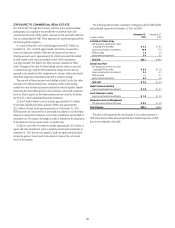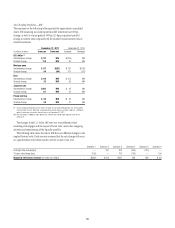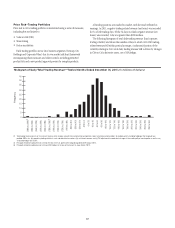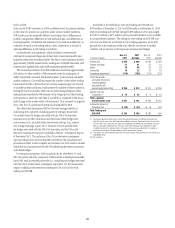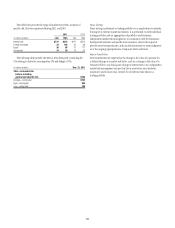Citibank 2011 Annual Report Download - page 111
Download and view the complete annual report
Please find page 111 of the 2011 Citibank annual report below. You can navigate through the pages in the report by either clicking on the pages listed below, or by using the keyword search tool below to find specific information within the annual report.
89
The unpaid principal balance of loans repurchased due to representation
and warranty claims for the years ended December 31, 2011 and 2010,
respectively, was as follows:
December 31, 2011 $ECEMBERææ
In millions of dollars
Unpaid principal
balance
5NPAIDæPRINCIPALææ
BALANCE
'3%S $505
0RIVATEæINVESTORS 8
Total $513
As evidenced in the tables above, Citi’s repurchases have primarily been
from the GSEs. In addition to the amounts set forth in the tables above, Citi
recorded make-whole payments of $530 million and $310 million for the
years ended December 31, 2011 and 2010, respectively.
Repurchase Reserve
Citi has recorded a reserve for its exposure to losses from the obligation to
repurchase or make-whole payments in respect of previously sold loans
(referred to as the repurchase reserve) that is included in Other liabilities
in the Consolidated Balance Sheet. In estimating the repurchase reserve,
Citi considers reimbursements estimated to be received from third-party
correspondent lenders and indemnification agreements relating to previous
acquisitions of mortgage servicing rights. The estimated reimbursements are
based on Citi’s analysis of its most recent collection trends and the financial
solvency of the correspondents.
In the case of a repurchase of a credit-impaired SOP 03-3 loan, the
difference between the loan’s fair value and unpaid principal balance at the
time of the repurchase is recorded as a utilization of the repurchase reserve.
Make-whole payments to the investor are also treated as utilizations and
charged directly against the reserve. The repurchase reserve is estimated
when Citi sells loans (recorded as an adjustment to the gain on sale, which is
included in Other revenue in the Consolidated Statement of Income) and is
updated quarterly. Any change in estimate is recorded in Other revenue.
The repurchase reserve is calculated by individual sales vintage (i.e., the
year the loans were sold). During 2011, the majority of Citi’s repurchases
continued to be from the 2006 through 2008 sales vintages, which also
represented the vintages with the largest loss severity. An insignificant
percentage of repurchases have been from vintages prior to 2006, and Citi
continues to believe that this percentage will continue to decrease, as those
vintages are later in the credit cycle. Although still early in the credit cycle,
Citi continued to experience lower repurchases and loss per repurchase or
make-whole from post-2008 sales vintages.
The repurchase reserve is based on various assumptions. These
assumptions contain a level of uncertainty and risk that, if different from
actual results, could have a material impact on the reserve amounts
(see “Sensitivity of Repurchase Reserve” below). The most significant
assumptions used to calculate the reserve levels are as follows:
Loan documentation requests: Assumptions regarding future expected
loan documentation requests exist as a means to predict future repurchase
claim trends. These assumptions are based on recent historical trends in
loan documentation requests, recent trends in historical delinquencies,
forecasted delinquencies and general industry knowledge about the
current repurchase environment. During 2011, the actual number of loan
documentation requests declined as compared to 2010. However, because
such requests remain elevated from historical levels, and because of the
continued increased focus on mortgage-related matters, the assumption
for estimated future loan documentation requests increased during 2011.
Citi currently believes the level of actual loan documentation requests will
remain elevated from historical levels and will continue to be volatile.
Repurchase claims as a percentage of loan documentation requests:
Given that loan documentation requests are a potential indicator
of future repurchase claims, an assumption is made regarding the
conversion rate from loan documentation requests to repurchase claims,
which assumption is based on historical performance. During 2011, the
conversion rate, or the number of repurchase claims as a percentage of
loan documentation requests, increased as compared to 2010, and thus
the assumption regarding future repurchase claims also increased. Citi
currently believes the claims as a percentage of loan documentation
requests will remain at elevated levels.
Claims appeal success rate: This assumption represents Citi’s
expected success at rescinding a claim by satisfying the demand for
more information, disputing the claim validity, or similar matters. This
assumption is based on recent historical successful appeals rates, which
can fluctuate based on changes in the validity or composition of claims.
During 2011, Citi’s appeal success rate remained stable as compared
to 2010, meaning approximately half of the repurchase claims were
successfully appealed and resulted in no loss to Citi.
Estimated loss per repurchase or make-whole: The assumption of
the estimated loss per repurchase or make-whole payment is based on
actual and estimated losses of recent historical repurchases/make-whole
payments calculated for each sales vintage year in order to capture
volatile housing price highs and lows. The estimated loss per repurchase
or make-whole payment assumption is also impacted by estimates of loan
size at the time of repurchase or make-whole payment. During 2011, the
severity of losses increased slightly as compared to 2010, but was more
than offset by the reduction in loan size, resulting in a decline in the
actual loss per repurchase or make-whole payment. Citi would expect to
continue to see reductions in loan size, including for the 2006 to 2008
sales vintages, as the loans continue to amortize through the loan cycle.


